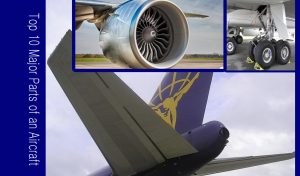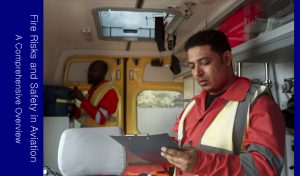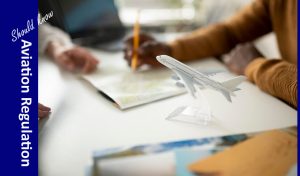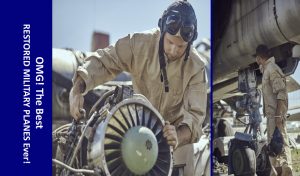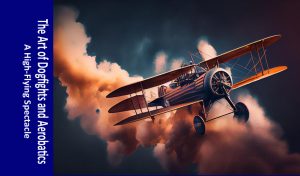Describing the world’s most iconic aircrafts technically and comparing them with others is a comprehensive task. Here, I’ll provide a brief technical overview of some iconic aircraft, along with reasons for their significance and Series-Models/versioning.
1. Boeing 747:
Overview
The Boeing 747, an aviation legend known as the “Queen of the Skies,” emerged in the mid-20th century against a backdrop of surging demand for long-distance air travel. Boeing responded to the industry’s call for larger and more efficient commercial aircraft, driven by the vision of Juan Trippe, the CEO of Pan American World Airways (Pan Am). This ambitious endeavor materialized as the CX-HLS (Cargo Experimental-Heavy Logistics System) project, which eventually gave birth to the 747. On September 30, 1968, the inaugural Boeing 747 prototype took to the skies in Everett, Washington, marking a monumental moment in aviation history. With its distinctive humpbacked upper deck and impressive capacity, the 747 transformed air travel by making long-haul flights more accessible and cost-effective. Over the decades, the 747 family evolved to include various models, such as the -200, -300, -400, and the modern -8, each contributing to its enduring legacy as a symbol of innovation and global connectivity in the aviation world.
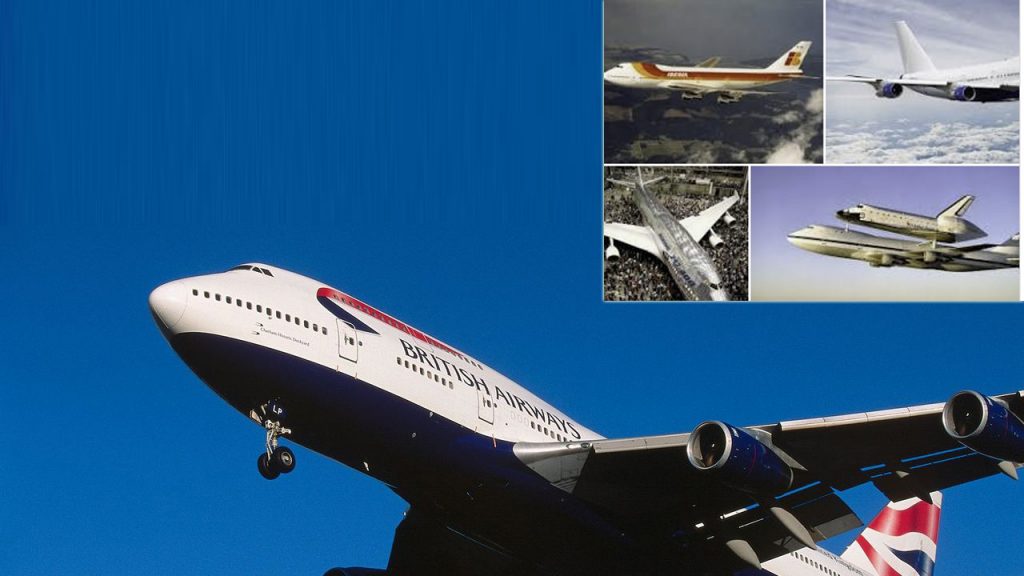
Here’s a brief technical overview of the Boeing 747, highlighting its design, technology, and key features.
Production:
The production of the Boeing 747, a pioneering and iconic aircraft, was a monumental endeavor that spanned several decades and involved complex manufacturing processes. Boeing’s manufacturing facilities, notably the Boeing Everett Factory in Washington state, played a crucial role in this endeavor. The production process began with the assembly of various components, including the fuselage, wings, and tail sections, all of which required precision engineering. The unique humpbacked design of the 747’s upper deck added complexity to the production, as did the integration of powerful turbofan engines and advanced avionics systems. Skilled workers meticulously assembled these components, ensuring structural integrity and safety. The production line witnessed various iterations, with each new model incorporating technological advancements and design improvements. Over the years, Boeing’s commitment to innovation and efficiency in manufacturing, combined with the dedication of its workforce, led to the successful production of numerous 747 aircraft that would go on to revolutionize long-haul air travel and leave an indelible mark on aviation history.
Design:
- Wide-Body Configuration: The Boeing 747 is a wide-body commercial airliner, which means it has a larger fuselage than narrow-body aircraft, providing more cabin space.
- Distinctive Humpbacked Fuselage: One of the most recognizable features of the 747 is its distinctive humpbacked or “bulging” upper deck, which sets it apart from other aircraft.
- High-Wing Configuration: The wings of the 747 are mounted high on the fuselage, allowing for a large cargo hold beneath the main deck.
- Four Turbofan Engines: The 747 is powered by four powerful turbofan engines, typically mounted on pylons under the wings. These engines provide the necessary thrust for long-haul flights.
- Double-Decker Design: The 747 is a double-deck aircraft with both a main deck and an upper deck. The upper deck is often used for premium seating, lounges, or bars, depending on the airline’s configuration.
- Retractable Landing Gear: The aircraft is equipped with retractable landing gear, including the nose gear and multiple main landing gear assemblies, which retract into the fuselage during flight.
- Tail Fin and Stabilizers: The tail of the 747 features a vertical tail fin and horizontal stabilizers, which provide stability and control during flight.
- Large Passenger Windows: The aircraft is equipped with large passenger windows to provide natural light and visibility to passengers.
- Cargo Capabilities: In addition to carrying passengers, the 747 has significant cargo capabilities in its lower deck, making it versatile for transporting both people and goods.
- Advanced Avionics: The 747 is equipped with advanced avionics and navigation systems, including autopilot and flight management systems, to ensure safe and efficient operation.
- Swept Wings: The wings of the 747 feature a swept-back design, which enhances aerodynamic efficiency and contributes to its long-range capabilities.
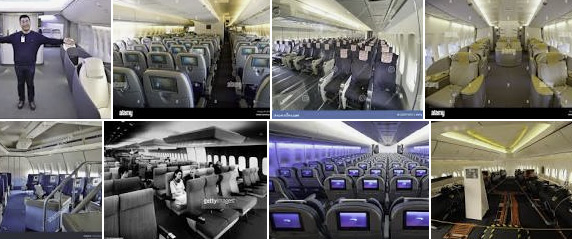
Technology:
- Advanced Jet Engine Technology: The 747 is powered by advanced turbofan engines that offer high thrust and fuel efficiency, contributing to its long-range capabilities.
- Fly-by-Wire System: The aircraft features a fly-by-wire flight control system, which uses electronic signals to transmit pilot inputs to control surfaces, enhancing flight stability and control.
- Avionics Suite: Equipped with modern avionics systems, including navigation, communication, and autopilot systems, ensuring safe and precise navigation during all phases of flight.
- Glass Cockpit: The flight deck of the 747 typically features a modern glass cockpit with electronic flight instrument systems (EFIS), reducing the reliance on traditional analog instruments.
- Advanced Materials: The use of lightweight, high-strength materials in the construction of the aircraft, such as composites and advanced alloys, contributes to its efficiency and durability.
- Digital Engine Control: The engines are equipped with digital engine control systems (FADEC), which optimize engine performance, fuel efficiency, and reduce maintenance requirements.
- Fuel-Efficient Design: The aircraft’s aerodynamic design and advanced engine technology result in improved fuel efficiency, reducing operating costs and environmental impact.
- Navigation and Communication Systems: The 747 is equipped with sophisticated navigation systems, including GPS, and communication systems to ensure effective communication with air traffic control and ground stations.
- Enhanced Safety Features: Incorporates a range of safety features such as terrain awareness and warning systems (TAWS), collision avoidance systems, and redundant systems to enhance safety.
- Noise Reduction Technology: The 747 utilizes noise reduction technology in its engines and design to comply with noise regulations and provide a quieter passenger experience.
- Maintenance Technology: Advanced diagnostic and maintenance systems assist in monitoring the aircraft’s health, enabling proactive maintenance to ensure continued safety and reliability.
- Cabin Technology: The interior of the 747 often includes modern cabin amenities, such as in-flight entertainment systems, Wi-Fi connectivity, and comfortable seating arrangements to enhance the passenger experience.
Boeing 747 series-Models and versioning Features:
The Boeing 747 series consists of several different models, each with its own variations and improvements over time. As of my knowledge here are the main Boeing 747 series:
- Boeing 747-100: The original model, was introduced in the late 1960s. It was the first commercial version of the 747 and set the stage for the subsequent series.
- Boeing 747-200: Introduced with extended range and increased passenger capacity compared to the -100 series. It became a workhorse for many airlines and had several subvariants, including the 747-200B, 747-200C (Combi), and 747-200F (Freighter).
- Boeing 747SP (Special Performance): A shorter version of the 747-100/200 with increased range. It was designed for long-haul, non-stop flights and was often used by airlines for routes with limited demand.
- Boeing 747-300: Featured a stretched upper deck and improved aerodynamics. It offered increased seating capacity compared to earlier models.
- Boeing 747-400: Introduced in the late 1980s, it was a significant upgrade over previous models. It had a two-person flight deck, an advanced EFIS (Electronic Flight Instrument System), and an improved range. It was widely adopted by airlines worldwide.
- Boeing 747-400ER (Extended Range): This variant offered increased range capabilities, making it suitable for ultra-long-haul flights.
- Boeing 747-400D: A domestic version of the 747-400, primarily used within Japan for high-density domestic routes.
- Boeing 747-8: The latest version of the 747 series, introduced in two main variants: the 747-8 Intercontinental (747-8I) for passengers and the 747-8 Freighter (747-8F) for cargo. It features advanced aerodynamics, quieter engines, and improved fuel efficiency. The -8I offers a spacious and modern interior for long-haul passenger travel.
2. Airbus A380:
Overview
The Airbus A380, often referred to as the “Superjumbo,” is a flagship long-range commercial aircraft designed to revolutionize air travel. Developed by Airbus, it entered service in 2007 and quickly became renowned for its enormous passenger capacity, typically accommodating between 555 and 853 passengers. Its distinctive double-deck design and spacious interior offer passengers a comfortable and luxurious flying experience. The A380 boasts impressive range capabilities, capable of flying over 8,000 nautical miles on a single tank of fuel. With advanced technology, soundproofing, and various cabin configurations, the Airbus A380 has left an indelible mark on the aviation industry, providing airlines and passengers with an iconic symbol of modern air travel.
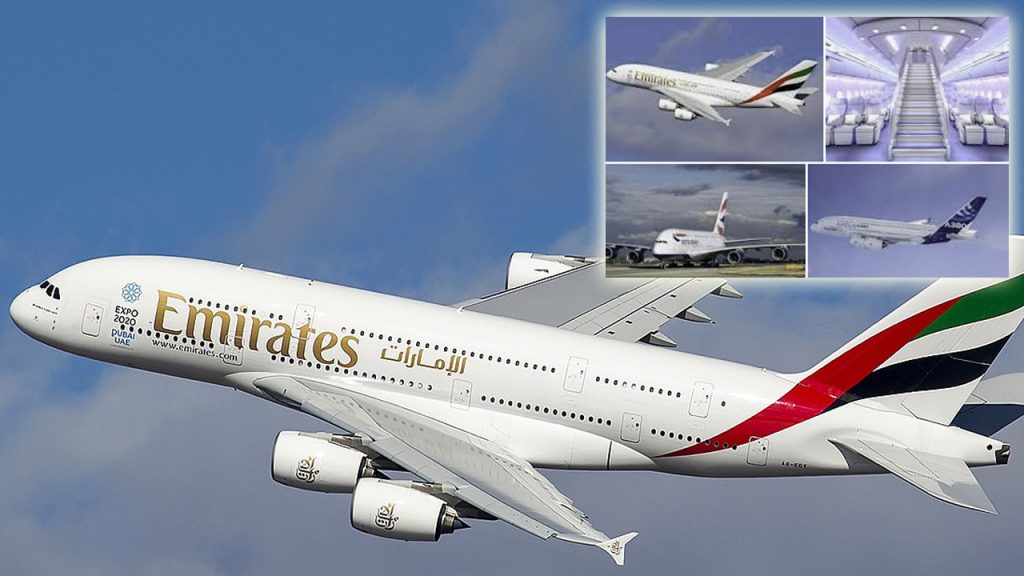
Production:
The production of the Airbus A380 was a massive undertaking involving advanced engineering and manufacturing processes. Components for the A380 were produced across Europe and then transported to the final assembly line in Toulouse, France. The assembly line featured specialized stations for various sections of the aircraft, such as the fuselage, wings, and tail. The A380’s unique double-deck design added complexity to the assembly process. Skilled workers meticulously integrated thousands of components, including advanced avionics and four powerful engines. The production of the A380 aimed not only for technological excellence but also for environmental efficiency, with features like quieter engines and reduced fuel consumption. Despite being an engineering marvel, the A380 faced challenges due to changing market dynamics, and Airbus announced the discontinuation of the program in 2019. Nevertheless, the A380 remains an iconic and groundbreaking aircraft in aviation history.
Design:
- Double-Decker Configuration: The A380 is a double-deck aircraft with two full-length passenger decks, offering increased cabin space and passenger capacity.
- Impressive Capacity: It typically accommodates between 555 and 853 passengers in a two-class or three-class configuration, making it one of the largest commercial airliners.
- Wingspan: The A380 boasts an impressive wingspan of approximately 261 feet (79.75 meters), contributing to its lift capabilities for long-haul flights.
- Four Engines: Powered by four high-bypass turbofan engines, such as the Rolls-Royce Trent 900 and Engine Alliance GP7200, providing the necessary thrust for its size and weight.
- Advanced Wing Design: The wings feature advanced aerodynamics, including swept-back wings and winglets, to enhance fuel efficiency and performance.
- Quiet Interior: The A380 incorporates soundproofing materials and cabin pressure control systems to reduce noise levels and passenger fatigue.
- Customizable Cabin Layouts: Airlines have the flexibility to configure the interior to include various seating classes, premium cabins, lounges, and bars.
- Upper Deck Features: The upper deck provides opportunities for premium cabins, spacious seating, and unique onboard features, enhancing passenger comfort.
- Cargo Capacity: In addition to passengers, the A380 offers significant cargo capacity in its lower deck, making it versatile for transporting both passengers and freight.
- Advanced Avionics: Equipped with state-of-the-art avionics, navigation, and communication systems to ensure safe and efficient operation.
- Long-Range Capability: With a range of over 8,000 nautical miles (approximately 14,800 kilometers), the A380 is suitable for long-haul, transoceanic flights.
- Innovative Materials: The aircraft’s construction incorporates lightweight and high-strength materials to maximize efficiency and structural integrity.
- Distinctive Design: The A380’s design is characterized by its double-deck fuselage, sleek lines, and advanced technology, setting it apart as a modern and iconic aircraft.
These design features collectively contribute to the Airbus A380’s reputation as a spacious, comfortable, and technologically advanced aircraft, ideal for long-distance air travel.
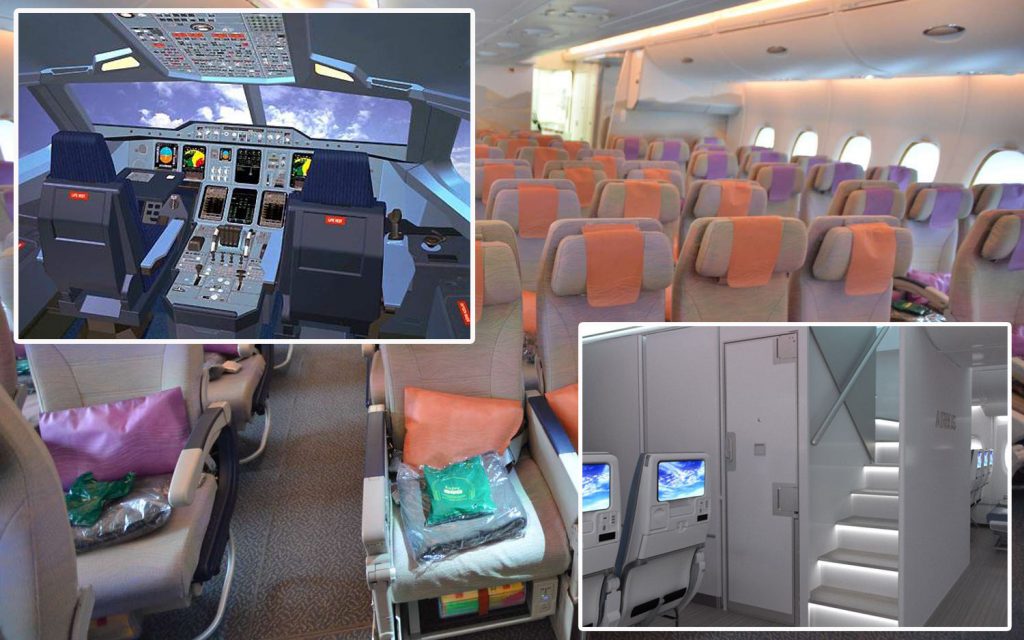
Technology:
- Fly-by-Wire Flight Control System: The A380 employs a fly-by-wire system, where electronic signals replace traditional mechanical control systems, enhancing flight stability and control.
- Advanced Avionics: Equipped with modern avionics systems, including electronic flight instrument systems (EFIS), navigation aids, and communication systems for precise navigation and communication with air traffic control.
- Glass Cockpit: The flight deck features a glass cockpit with advanced digital displays, reducing the reliance on traditional analog instruments and enhancing situational awareness for the flight crew.
- Powerful Turbofan Engines: The A380 is powered by four high-bypass turbofan engines, offering high thrust and improved fuel efficiency. Engine options include Rolls-Royce Trent 900 and Engine Alliance GP7200.
- Aerodynamic Innovations: The aircraft’s aerodynamics are optimized for fuel efficiency, with features such as swept-back wings and winglets to reduce drag and improve performance.
- Fuel Efficiency: The A380 incorporates fuel-efficient technologies, including lightweight materials and wing design, to reduce fuel consumption and environmental impact.
- Quiet Cabin: Advanced soundproofing materials and cabin pressure control systems minimize noise levels inside the cabin, providing a quieter and more comfortable passenger experience.
- Customizable Cabin Layouts: Airlines can configure the interior layout to include various seating classes, premium cabins, lounges, bars, and amenities to cater to passenger preferences.
- Advanced Landing Gear: The A380 features retractable landing gear with multiple wheels to distribute the aircraft’s weight evenly during takeoff and landing, reducing stress on runways.
- Efficient Cargo Handling: The aircraft offers significant cargo capacity in its lower deck, with efficient cargo handling systems for transporting both passengers’ luggage and cargo.
- Environmental Considerations: The A380 incorporates eco-friendly features, such as reduced emissions, to meet stringent environmental regulations and improve sustainability in aviation.
- Long-Range Capability: With a range of over 8,000 nautical miles (approximately 14,800 kilometers), the A380 is suitable for long-haul, transoceanic flights, connecting distant destinations efficiently.
These technological advancements collectively contribute to the Airbus A380’s reputation as a state-of-the-art aircraft, offering passengers a comfortable and efficient mode of long-distance air travel while meeting environmental standards and industry demands.
Airbus A380 series-Models and Versioning Features:
The Airbus A380 has gone through several models and versions over the years, each with its own improvements and variations. Here is an overview of the key models and versions of the Airbus A380:
1. Airbus A380-800:
- This is the baseline model and the first production version of the A380.
- It entered commercial service in 2007 with Singapore Airlines.
- Various airlines have operated the A380-800 with different cabin configurations and layouts.
2. Airbus A380-800R (Extended Range):
- The -800R variant was designed to offer increased range capabilities, allowing it to operate longer-distance routes.
- Modifications to the fuel system and structural enhancements extended its range.
3. Airbus A380F (Freighter):
- Airbus had plans for a dedicated freighter version of the A380, known as the A380F.
- However, due to limited demand for large cargo aircraft, Airbus suspended the A380F program in 2007.
4. Airbus A380-900 (Proposed):
- Airbus explored the possibility of stretching the A380 to create an A380-900 variant.
- This stretched version would have accommodated even more passengers, but it was never developed beyond the concept stage due to limited market demand.
5. Airbus A380plus (Concept):
- Airbus proposed the A380plus as a concept aimed at increasing the A380’s efficiency and capacity.
- It featured aerodynamic enhancements, including larger winglets and cabin layout improvements.
6. Airbus A380neo (Proposed):
- There were discussions about developing a “neo” (new engine option) version of the A380 with more fuel-efficient engines to improve the aircraft’s operating economics.
- This project did not progress beyond discussions, and Airbus eventually discontinued the A380 program altogether in 2019.
The primary model in commercial operation has been the A380-800, with various airlines customizing their interiors to suit their specific needs. While Airbus explored several variations and improvements, the program faced challenges related to market demand, leading to the discontinuation of production.
3. Concorde:
Overview
The Concorde, a marvel of aviation engineering, was the world’s first supersonic passenger aircraft. Introduced in 1976, it could fly at an astonishing Mach 2.04, more than twice the speed of sound, reducing transatlantic flights to a mere 3.5 hours. With a capacity of around 100 passengers, the Concorde offered a luxurious travel experience, complete with gourmet dining and spacious seating. It linked cities like London, Paris, New York, and Washington, D.C., setting the standard for rapid and opulent air travel. However, faced with high operating costs and noise restrictions, the Concorde retired from commercial service in 2003, leaving behind a legacy of aviation innovation and luxury travel.
Production:
The production of the Concorde aircraft was a remarkable feat of collaboration and innovation. Developed jointly by British Aircraft Corporation (BAC) in the United Kingdom and Aérospatiale in France, this supersonic passenger jet project began in the early 1960s. The design and engineering teams faced formidable challenges in creating an aircraft capable of flying faster than the speed of sound while ensuring safety, efficiency, and comfort for passengers. Two prototypes, Concorde 001 and Concorde 002, underwent extensive testing and certification processes before production commenced. The aircraft were manufactured in both the UK and France, with components assembled at final assembly lines in Filton, England, and Toulouse, France. In 1976, Concorde entered commercial service, revolutionizing air travel with its unprecedented speed and luxury. However, operational challenges, including high operating costs and noise restrictions, ultimately led to its retirement in 2003. Despite its limited production of only 20 aircraft, the Concorde left an indelible mark on aviation history as a symbol of technological achievement and supersonic travel.
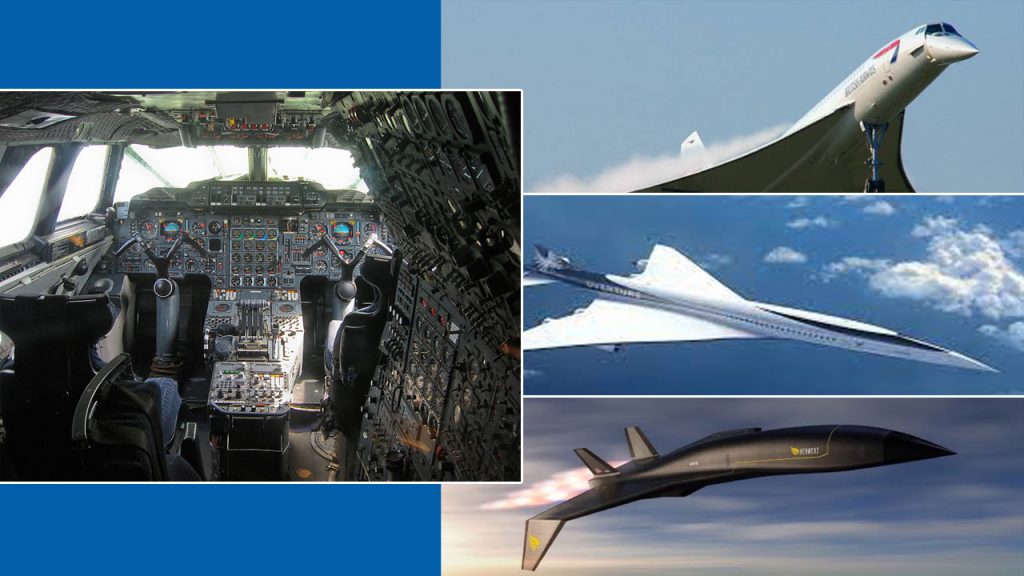
Design:
- Aerodynamic Shape: The Concorde’s design was characterized by its slim, elongated fuselage, slender delta wings, and pointed nose. Its streamlined shape minimized drag and allowed it to achieve supersonic speeds efficiently.
- Delta Wings: The Concorde’s delta wings had a distinctive triangular shape with a high aspect ratio. These wings were designed for both subsonic and supersonic flight, providing the necessary lift and stability throughout the flight envelope.
- Variable Inlet Ramp: The aircraft featured variable inlet ramps on its engines. These ramps could adjust to optimize the intake of air for the engines, ensuring efficient combustion at different speeds and altitudes.
- Four Turbojet Engines: The Concorde was powered by four Rolls-Royce Olympus or Pratt & Whitney JT8D turbojet engines. These engines provided the thrust necessary to break the sound barrier and sustain supersonic flight.
- Swept-Back Tail: The tail of the Concorde featured a swept-back design, which aided in aerodynamic stability and control during flight.
- Nose Cone Droop: The Concorde had a unique feature—a drooping nose cone. This feature allowed the nose to be lowered during takeoff and landing to improve visibility for the flight crew. It would be raised to its normal position for supersonic flight.
- Luxurious Interior: Inside the Concorde, passengers experienced a luxurious and spacious cabin, with comfortable seating and amenities. The aircraft offered a premium travel experience with gourmet dining and personalized service.
- Soundproofing: Advanced soundproofing materials were used in the cabin to reduce the noise generated by supersonic flight, ensuring a more comfortable environment for passengers.
- Supersonic Speed: The Concorde’s design allowed it to reach speeds of approximately Mach 2 (twice the speed of sound), significantly reducing travel times for transatlantic flights.
- Operational Range: It had a range of around 4,000 nautical miles (7,400 kilometers), allowing it to operate on transatlantic routes with ease.
The Concorde’s design was a testament to the engineering ingenuity of its creators. Its iconic appearance and groundbreaking technology made it one of the most recognizable and celebrated aircraft in aviation history.
Technology:
The Concorde was a pioneering supersonic passenger aircraft known for its sleek and distinctive design. Here are some key design features of the Concorde:
- Supersonic Aerodynamics: The Concorde’s slender delta wings and streamlined fuselage were specifically designed to minimize drag and generate the lift needed to reach and sustain supersonic speeds.
- Turbojet Engines: The Concorde was powered by four Rolls-Royce Olympus turbojet engines (later models used Pratt & Whitney engines). These engines provided the necessary thrust to accelerate the aircraft to supersonic velocities.
- Variable Inlet Design: The Concorde’s engines featured variable inlet ramps that could adjust to control the intake of air, optimizing engine performance at different speeds and altitudes.
- Afterburners: The aircraft’s engines were equipped with afterburners, which injected additional fuel into the exhaust stream to increase thrust during supersonic flight.
- Thermal Expansion: The Concorde’s airframe underwent significant thermal expansion during supersonic flight, which required advanced materials and structural design to accommodate the changes in temperature and pressure.
- Nose Cone Design: The drooping nose cone was a technological marvel that could be lowered for takeoff and landing to improve visibility for the flight crew. It would be raised during supersonic flight.
- Soundproofing: Advanced soundproofing materials and insulation were used throughout the cabin to reduce the intense noise generated during supersonic travel, providing passengers with a quieter and more comfortable environment.
- Advanced Navigation and Avionics: The Concorde was equipped with state-of-the-art navigation and avionics systems, including advanced radar, navigation aids, and flight control systems to ensure precise and safe flight.
- Hydraulic Systems: The Concorde relied on powerful hydraulic systems to control its flight surfaces, landing gear, and nose cone. These systems had to withstand high speeds and temperatures.
- Structural Materials: The aircraft’s structure incorporated advanced materials, such as titanium and aluminum alloys, to ensure strength, durability, and weight savings.
- Supersonic Speed: The Concorde’s technology allowed it to reach and sustain speeds of approximately Mach 2 (twice the speed of sound), enabling rapid transatlantic travel.
- Customized Cabin: The interior of the Concorde featured customized luxury seating, comfortable amenities, and fine dining services to provide a premium travel experience.
The Concorde represented a remarkable fusion of engineering and technology, allowing it to push the boundaries of aviation by making supersonic commercial travel a reality. Despite its retirement, the Concorde remains an enduring symbol of aerospace achievement.
Concorde series-Models and versioning Features:
The Concorde, a pioneering supersonic passenger aircraft, had two primary models during its operational history:
- Aérospatiale-BAC Concorde 001:
- The Concorde 001 was the first prototype and the first aircraft built as part of the Concorde program.
- It conducted its maiden flight on March 2, 1969, from Toulouse, France.
- The purpose of this prototype was to test the aircraft’s aerodynamics, systems, and performance.
- It never entered commercial service and is now on display at the Musée de l’Air et de l’Espace in France.
- Aérospatiale-BAC Concorde 002:
- The Concorde 002 was the second prototype and was built by the British Aircraft Corporation (BAC).
- It conducted its maiden flight on April 9, 1969, from Filton, England.
- Like the Concorde 001, its primary purpose was to test and validate the Concorde’s design and technology.
- It also did not enter commercial service and is displayed at the Fleet Air Arm Museum in the UK.
These two prototypes paved the way for the development of the production version of the Concorde, which was simply known as the “Concorde.” The Concorde 001 and Concorde 002 played crucial roles in proving the feasibility of supersonic passenger travel and contributed to the development of the operational Concorde fleet.
The operational Concorde fleet did not have multiple models or versions; however, there were various modifications and improvements made over the years to enhance safety and efficiency. These modifications included changes to the engines, avionics, and materials, among others. Nonetheless, the core design and capabilities of the Concorde remained consistent throughout its operational life.
